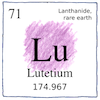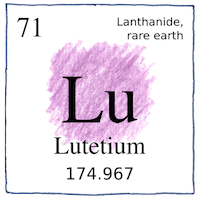Paris, Vienna, Durham—Georges Urbain,
Carl Auer von Welsbach,
Charles James
elements

|
Lutetium
In 1907, Georges Urbain separated the mineral ytterbia into two oxides— neoytterbia and lutecia. In 1907, Carl Auer von Welsbach separated the mineral ytterbia into two oxides— aldebarania and cassiopeia. In 1907, Charles James separated the mineral ytterbia into two oxides— but he withdrew his publication. Urbain was the first to publish so the sixteenth rare earth was given the Roman name for Paris.
Atomic number 71
Catalyst, dopant, phosphor. Lutetium tantalate is the densest, stable white material. What do you say about that?
Synchronicity
One way to tell the time was right is by the number of simultaneous discoveries. As though all at once a hundred ships sailed west from different eastern ports, none aware of the others but each gambling on the unexpected, one would suspect a hidden connection, even if only three made it to a distant shore.



The chemists that discovered lutetium shared the same map, the periodic table. Before their reports, two lanthanoids were missing. Urbain, Auer, and James found the element with atomic number 71. The element with atomic number 61 still eluded intrepid sailors.
See also in The book of science:
Readings in wikipedia:
Other readings: